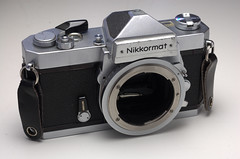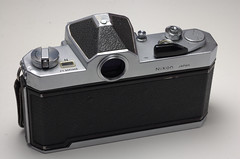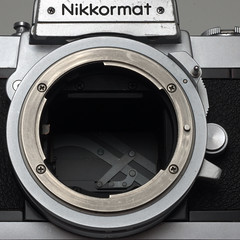Nikomat/Nikkormat FTN

|
| Nikkormat FTN image by Steve Harwood (Image rights) |
Introduction
The Nikomat/Nikkormat FTN Nippon Kōgaku was a successful and lauded iteration of the Nikomat/Nikkormat FT series. Introduced in 1967, the FTN is built on substantially the same chassis as the FT, but had center-weighted metering instead of whole-frame average metering, a shutter-speed display in the viewfinder, a few other minor changes, and, critically, a simplified process for mounting the lens.
The Nikkormat series was the budget range of Nikon SLR's, aimed at those who could not afford the professional range (including the Nikon F). However, for several reasons, the Nikkormat achieved a significant following. For one thing, some professionals preferred the smaller, cheaper and simpler Nikkormats. For another, the camera has an extremely reliable metal-blade focal-plane shutter, based on the Copal Square, known for its high X-speed, durability and accuracy. In the eyes of some, this puts it ahead of the Nikon F technically, though this feature would be picked up in the professional range at a later date, and in fact the two lines would be folded together in the Nikon FE.
In a way, the early Nikkormats can be seen as the successors of the Nikkorex F, a Mamiya-made, Nikon-branded body with the original Copal Square (it was the first SLR to have it). This Nikkorex was a step up from the other Nikkorexes, taking F-mount lenses and a clip-on meter, and in fact filled a new niche for Nippon Kougaku, what we might now call the "prosumer" niche, between amateur and professional-grade equipment. By introducing the metal-blade shutter type and pioneering the marketing strategy, the Nikkorex F paved the way for the Nikkormats.
The Nikkormat FTN represents the most common of the FT series Nikkormats, having been made for almost ten years. Its predecessor introduced the body type and most of the basic features, while the FTN added some much-needed fit-and-finish, and the FT2 and FT3 continued to refine the same body style.
The FTN was produced until 1976, with minor modifications.
Physical description
The camera is a fairly conventional SLR in the layout of the chassis. However, there are some unusual features that give the camera an unusual look: the shutter speed selector is, as on many fixed-lens cameras, but few SLR's, a ring around the lens mount. This may at first seem like an inconvenience, but it puts both the exposure controls in the same place, and frees up the top of the camera for other things. To wit, the camera features a very large magnified frame counter where many cameras would have the shutter-speed dial, as well as a depth of field preview button that can be mistaken for a second shutter release, closer to the pentaprism. The apparent inconvenience of the shutter-speed ring is also lessened by the fact that the shutter speed is always visible inside the viewfinder, a new feature of the FTN model.
Another reason for the camera's unusual appearance is the aperture coupling. This assembly is a ring that surrounds the lens mount, with a projecting prong. This device is a necessity of the Nikon F lens system, which reads the aperture via a slotted shoe on the lens's aperture ring. To mount a lens and meter it properly, the aperture must be set to 5.6, the prong must be moved to the far right (facing the camera), the lens must be attached to the camera and finally, the aperture ring must be turned all the way to the smallest aperture and then all the way to the largest aperture, in order to mechanically set the aperture range in the camera. A small scale on the aperture-sensing ring confirms the maximum aperture. This may seem complicated to photographers who are more used to later SLR's, but it is in fact a simplification from the Nikkormat FT.
Another unusual feature is an external meter needle in addition to the one in the viewfinder. The manual describes this as being a convenience for use at waist-level or when mounted on a tripod.
Shutter
The shutter is substantially the design which Mamiya, Yashica and Copal (among others) came together to design in the late 1960's, which was marketed by Copal as the Copal Square and first mounted by Mamiya in the Nikkorex F (and derivatives). It is a fully-mechanical focal-plane shutter, with the moving elements being metal blinds being propelled by levers, instead of cloth curtains propelled by rollers. Unlike the Nikkorex Copal Square shutter, the Nikkormat shutter seems to be made in-house, rather than by Copal, and has the levers on the mirror-box side, rather than the film side. Shutter speeds run from 1/1000s to 1s and B, with intermediate speeds available between 1/1000s and 1/250s.
Metering
When the lens and the shutter speed have finally been properly set, the camera acts as a fairly conventional center-the-needle metered-manual camera, metering with the aperture wide open. The meter is activated by pulling out the film-advance lever slightly, revealing a red dot. There is a needle at the right-hand side of the viewfinder, between a bracket marked with a "-" and one marked with a "+." Confusingly, the plus and minus marks indicates over- and underexposure, respectively; the plus sign, for instance, does not indicate that the exposure should be increased. If the needle centers with the shutter at "B," the photographer should use a tripod and hold the shutter for two seconds.
The second meter needle merely has a circle to indicate the proper exposure, though "+" and "-" signs were added to the next model.

|

|

|

|
| bayonet and shutter | Nikkor-S 35mm lens images by Harri Haataja (Image rights) |
Links
- Nikkormat FTN at Nikon's History & Technology site
- Manual Camera User's Opinion
- Nikomat & Nikkormat FTN Camera Bodies" in Richard de Stoutz' "Nikon F Collection & Typology"
- Nikkormat FT noir on www.collection-appareils.fr by Sylvain Halgand (in French)
- Nikkormat at Classic Cameras by RaúlM.
- Instruction Manual - English at at M.Butkus' www.orphancameras.com
- Nikkormat FTN page at Camera Portraits
| Nikon 35mm SLR Cameras | |
|---|---|
| Nikkorex F | Nikon EL2 | Nikon EM | Nikon F | Nikon F2 | Nikon F3 | Nikon F4 | Nikon F5 | Nikon F6 | Nikon F50 | Nikon F55 | Nikon F60 | Nikon F65 | Nikon F70 | Nikon F75 | Nikon F80 | Nikon F90 | Nikon F90X | Nikon F100 | Nikon F-301 | Nikon F-401 | Nikon F-401S | Nikon F-401X | Nikon F-501 | Nikon F-601 | Nikon F-601M | Nikon F-801 | Nikon F-801s | Nikon FA | Nikon FE | Nikon FE2 | Nikon FE10 | Nikon FG | Nikon FG-20 | Nikon FM | Nikon FM2 | Nikon FM2n | Nikon FM3A | Nikon FM10 | |
| Nikomat / Nikkormat | |
| EL | EL2 | ELW | FS | FT | FT2 | FT3 | FTN | |